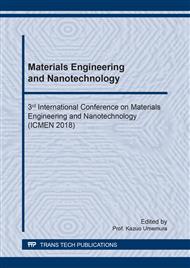[1]
K. Chu, Axial load behaviour of steel tube columns in-filled with various high-performance concretes, Master Thesis (2014), Ryerson University, Toronto, Ontario, Canada.
DOI: 10.32920/ryerson.14654235
Google Scholar
[2]
S. D. Nardin and Ana Lucia H. C. El Debs, Shear transfer mechanisms in composite columns: an experimental study, Steel and Composite Structures, Vol. 7(5) (2007) pp.377-390.
DOI: 10.12989/scs.2007.7.5.377
Google Scholar
[3]
H. Awang, M. H. Ahmad, and M. Z. Al-Mulali, Influence of kenaf and polypropylene fibres on mechanical and durability properties of fibre reinforced lightweight foamed concrete, J. Eng. Sci. Technol., Vol. 10(4) (2015) p.496–508.
Google Scholar
[4]
M. D. Subair, C. Fayas and Paul, An experimental study on the mechanical properties of steel fibered sand replaced of foamed concrete, Int. Res. J. Engineering Technol., Vol. 3 (2016) p.14.
Google Scholar
[5]
British Cement Association, Foamed Concrete: Composite and properties, Report 46.042 (1994).
Google Scholar
[6]
N. A. Rahman, Z. M. Jaini, and N. N. M. Zahir, Fracture Energy of Foamed concrete by means of the three-point bending tests on notched beam specimens, ARPN J. Eng. Appl. Sci., Vol. 10 (2015) p.6562–6570.
Google Scholar
[7]
M.A. Othuman Mydin, N. S. Sahidun, M. Y. Mohd Yusof, N. Md Noordin, Compressive, Flexural and Splitting Tensile Strength of Lightweight Foamed Concrete with Inclusion of Steel Fibre, Jurnal Teknologi, Vol. 75(5) (2015) p.45–50.
DOI: 10.11113/jt.v75.4962
Google Scholar
[8]
S. A. A. Khairuddin, N. A. Rahman, N. Jamaluddin, Z. M. Jaini, and N. Ali, Ultimate strength capacity of a square hollow section filled with fibrous foamed concrete, IOP Conference Series: Materials Science and Engineering, Vol. 271 (2017).
DOI: 10.1088/1757-899x/271/1/012103
Google Scholar
[9]
S. Tokgoz and C. Dundar , Experimental Study on Steel Tubular Columns In-filled with Plain and Steel Fiber Reinforced Concrete, Thin-Walled Struct., Vol. 48 (2010) p.414–422.
DOI: 10.1016/j.tws.2010.01.009
Google Scholar
[10]
H. Geetha and T. Swedha, An Experimental study on Concrete Filled Tubular Columns Using Varying Steel Materials, International Journal of Innovative Science, Engineering & Technology ,Vol. 2 (2015) p.737–742.
Google Scholar
[11]
M. A. Al-mazini and A. H. Chkhewier, Behavior of Concrete Filled Aluminum Square and Rectangular Hollow Section Columns under Axial Loads: Experimental and Analytical Study, Journal of Babylon University, Engineering Sciences, Vol 25 (2) (2017).
Google Scholar
[12]
M. N. Baig, F. Jiansheng and N. Jianguo, Strength of Concrete Filled Steel Tubular Columns Tsinghua, Science And Technology, Vol. 11(6) (2006) pp.657-666.
DOI: 10.1016/s1007-0214(06)70248-6
Google Scholar
[13]
M. D. O'Shea and R. Q. Bridge, Design of circular thin-walled concrete filled steel tubes, Journal of Structural Engineering, Vol. 126(11) (2000) pp.1295-1303.
DOI: 10.1061/(asce)0733-9445(2000)126:11(1295)
Google Scholar


